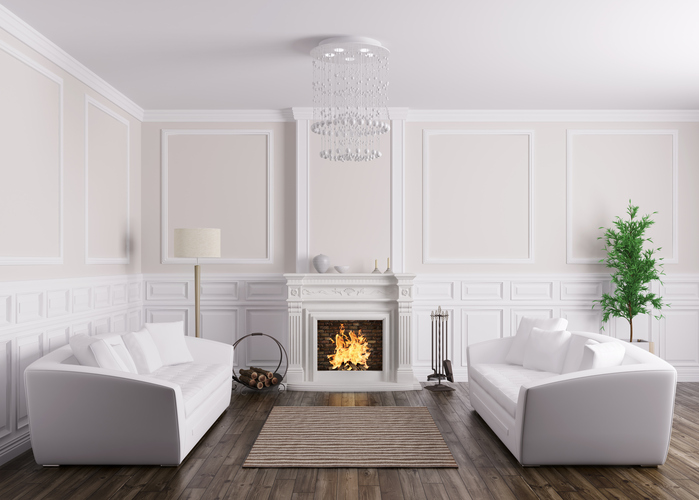Free Bay Area delivery on orders over $275. Orders will ship next business day. View Shipping/Return Policy.

It’s impossible to scroll through social media without seeing beautiful homes in some capacity. Whether you follow Instagram accounts dedicated to showcasing unique home décor, or you constantly see ads for all those home flipping shows, you’re sure to see some visually stunning interior decorating. And when you are hoping to upgrade the look of your home, it’s impossible to stop thinking about all the cool things you can do to your space! Wall paneling is an oft-forgotten, easy-to-incorporate detail that can instantly transform the look of any home.
Homeowners often come to us at The Moulding Company to discuss their options and figure out how they can transform their homes with a more restrictive budget. Wall paneling is an easy suggestion! If your walls are flat and dull, this is the perfect way to dress them up without entirely remodeling. Your home reflects you as a person, and adding wall paneling can be precisely what you need to showcase your refined taste. Could this be the right choice for your home? Take a look at the benefits of paneling to help you decide.
Easy to Install
The installation component is one of the biggest reasons people postpone home improvement projects. A home redesign tends to be tedious and time-consuming. Additionally, the expense can also be a pain point if you’re hiring a professional to do it.
Fortunately, wall paneling doesn’t fit in this category. Because of the ease of installation, wall paneling is an excellent do-it-yourself project for those who consider themselves handy or willing to put in the work and learn. Tongue-and-groove designs and clipping systems make installation easier than assembling some children’s toys. All you need are the correct dimensions, the right supplies, suitable tools, and a little free time to mount the panels to your walls.
Plenty of Material Choices
While traditional wall paneling is wooden, this material is not your only option! Modern materials such as medium-density fiberboard and melamine are more durable and impact-resistant, making them suitable for high-traffic areas when scuffing and denting are likely to occur. Melamine is moisture-resistant, allowing for installation in kitchens and bathrooms without fear of warping or rotting. With all these material options, something is bound to suit your needs.
Adding an accent wall is a relatively easy home improvement project because it’s reasonable to do the work and finish it in a single weekend. Peel and stick wallpaper has become a trendy element of the DIY home improvement circuit, and for a good reason! It’s affordable and easy to apply, even if you’ve never done wallpapering before.
Are you looking to try paneling in only one room in your home? A single wall, covered on the top half with peel and stick wallpaper and then complimented on the bottom with beautifully painted accent wall panels, can add enormous dimension to any room. It elevates the look from plain to stunning without the intense time, effort, or expense a remodel would take. Alternatively, add the same wallpaper and paneling around the entire room for an enormous wow factor and an incredible upgrade for the space!

Wall Paneling Offers Protection for Your Walls
Paneling isn’t just decorative. It also serves a functional purpose by protecting your walls from damage! Homeowners often choose baseboards, chair rails, or wall paneling to protect against everyday dings and dents that eventually appear on everyone’s walls.
You can choose to purchase impact-resistant paneling, which is less likely to be dented, scratched, or otherwise banged up for even more protection. Even when your wall paneling starts showing signs of wear and tear, cleaning or replacing a section of paneling is easier than repairing drywall.
Flexible Design Choices
There are numerous ways to cover your walls with paneling. Throughout history, the type of wall paneling in residential and commercial buildings has changed to reflect society’s tastes and trends. In the Tudor period, when British homes were first beginning to reflect comforts and not just practicalities, artisans carved patterns into the thin oak paneling that was popular then. It would often span the entire wall and was almost exclusively a feature of the homes of the wealthy.
On the other hand, paneling in the Victorian period was often capped off at chair level using what we call chair rail now. These panels were less ornate than the panels of the periods before but were still primarily found in wealthy homes.
Today, paneling is much more budget-friendly for people of all incomes! Because of this, there has been a resurgence of wall paneling projects that pull inspiration from all different periods. Reclaimed wood is a rustic option for creating accent wall panels in modern homes. Wainscoting adds character to the bottom half of the wall with beadboard or v-groove paneling and can look more like a Victorian-style option. Board and batten paneling draw your eye upward with vertical panels, while shiplap serves as a horizontal wall treatment. You can even create a profile of 3D wall panels.
Want something more colorful than the white common in modern design or the natural colors of wood used in historical applications? You can paint or stain paneling any way you want to suit your design tastes—another benefit of living in the present and not Tudor England!
Use As Camouflage for Unattractive Features
Maybe you have a noticeable dent in your living room wall or an unsightly chip in the kitchen wall that has distracted you to the point of burning dinner while you were cooking. Wall paneling can be a handsome coverup for these flaws and add a decorative element that positively catches the eye! Of course, you shouldn’t use paneling to cover up severe structural damage. Still, minor wear and tear or unattractive elements that only affect your walls aesthetically are okay to hide behind paneling.
Wall paneling, when used cleverly, can also be used to hide away unsightly or tangled cords. That’s why so many people use accent wall panels! You can even install it over rough or uneven surfaces to give the space a more even finish. Some people use elegant wall paneling to camouflage old, out-of-commission brick fireplaces.

Low Maintenance
As mentioned previously, wall paneling is much simpler to replace or repair than drywall, but it is also very low-maintenance. Of course, it depends on the material you choose for your paneling, but a microfiber cloth, some water, and a gentle cleanser are often all you need to wipe panels down and keep them looking their best.
Can Help with Soundproofing and Insulation
If you are looking for a simple way to add more soundproofing and insulation to your home, wall paneling can also help. Adding this layer to your walls can help keep warm air in during the winter and cool air in during the summer. It also acts as an additional buffer to sounds from outside your home or between rooms so that you can enjoy a quieter environment.
Improves Styling for a Custom Look
Wall paneling is associated with the upper class, as historically, decorative elements in a home were only affordable to the upper echelon. Traditional Colonial and Georgian interiors often featured wood panels to indicate the owner’s wealth. This concept still holds true today, so if you’re looking for a way to improve the style and richness of your home without investing a lot, paneling is an excellent option.
These are just some of the benefits you can expect from wall paneling. If you’re ready to install this upgrade in your home, let The Moulding Company help. We have a knowledgeable design staff and over five decades of experience to back us up. Visit one of our four showrooms in the San Francisco Bay Area to see wall paneling up close, or contact us today for a free quote on your upcoming project!

